-
Windows进程间利用管道通信
实验一
一、实验内容或题目:
在父进程中创建一个子进程,并建立一个管道,子进程向管道中写入一个字符串,父进程从管道中读出字符串。
二、实验目的与要求:
利用CRT相关接口,学习在父子进程间实现管道通信。
三、实验步骤(以windows和Visual Studio为例):
1、建立解决方案和项目(略)
2、参照课本3.7.5章节的例1,利用CRT LIB提供的相似性接口,实现相同的功能(使用Linux的同学调用相应的接口)
3、CRT相关api:_pipe, _spawn, _cwait, _read, _write。示例代码可以参照 :https://docs.microsoft.com/en-us/cpp/c-runtime-library/reference/pipe?view=msvc-160四、实验结果:
1)对示例代码的详细批注
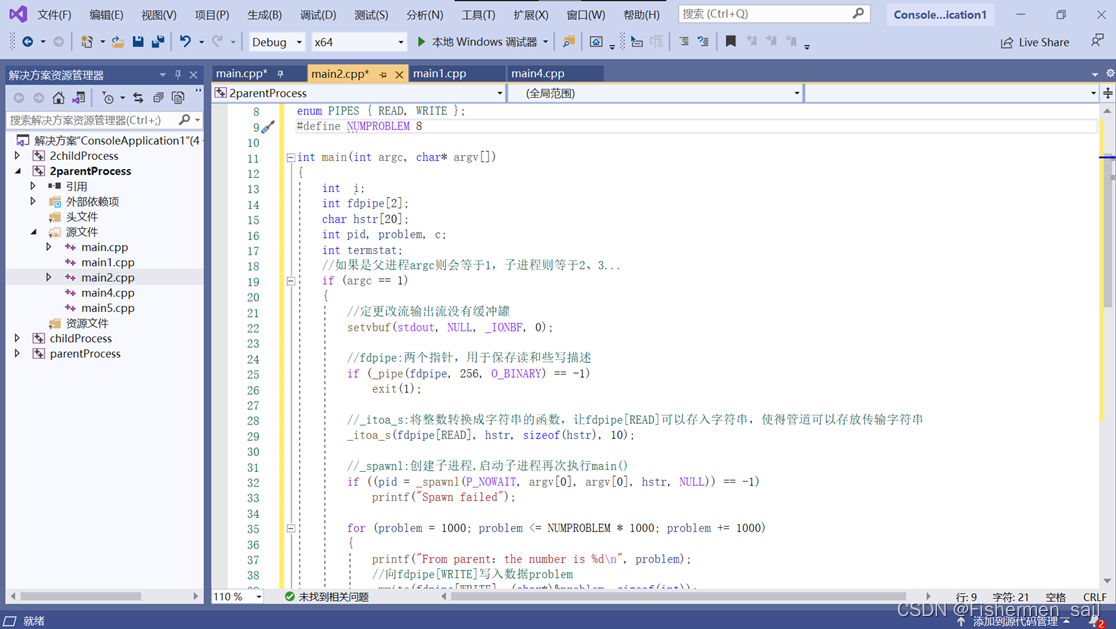

#include#include #include #include #include #include enum PIPES { READ, WRITE }; #define NUMPROBLEM 8 int main(int argc, char* argv[]) { int i; int fdpipe[2]; char hstr[20]; int pid, problem, c; int termstat; //如果是父进程argc则会等于1,子进程则等于2、3... if (argc == 1) { //定更改流输出流没有缓冲罐 setvbuf(stdout, NULL, _IONBF, 0); //fdpipe:两个指针,用于保存读和些写描述 if (_pipe(fdpipe, 256, O_BINARY) == -1) exit(1); //_itoa_s:将整数转换成字符串的函数,让fdpipe[READ]可以存入字符串,使得管道可以存放传输字符串 _itoa_s(fdpipe[READ], hstr, sizeof(hstr), 10); //_spawnl:创建子进程,启动子进程再次执行main() if ((pid = _spawnl(P_NOWAIT, argv[0], argv[0], hstr, NULL)) == -1) printf("Spawn failed"); for (problem = 1000; problem <= NUMPROBLEM * 1000; problem += 1000) { printf("From parent:the number is %d\n", problem); //向fdpipe[WRITE]写入数据problem _write(fdpipe[WRITE], (char*)&problem, sizeof(int)); } printf("dsa"); //等待子进程结束,回收子进程 _cwait(&termstat, pid, WAIT_CHILD); if (termstat & 0x0) printf("Child failed\n"); _close(fdpipe[READ]); _close(fdpipe[WRITE]); } else { //atoi:将参数转换为整数 fdpipe[READ] = atoi(argv[1]); for (c = 0; c < NUMPROBLEM; c++) { _read(fdpipe[READ], (char*)&problem, sizeof(int)); printf("From child, the number is %d\n", problem); } } } - 1
- 2
- 3
- 4
- 5
- 6
- 7
- 8
- 9
- 10
- 11
- 12
- 13
- 14
- 15
- 16
- 17
- 18
- 19
- 20
- 21
- 22
- 23
- 24
- 25
- 26
- 27
- 28
- 29
- 30
- 31
- 32
- 33
- 34
- 35
- 36
- 37
- 38
- 39
- 40
- 41
- 42
- 43
- 44
- 45
- 46
- 47
- 48
- 49
- 50
- 51
- 52
- 53
- 54
- 55
- 56
- 57
- 58
- 59
- 60
- 61
2)由于持续报这个错误,或者无法运行,网上资料太少,官网的解释也没能太看懂,调试了几天,依然未能够解决,放弃了使用_sprawl(createProcess只是在创建子进程时比它能控制更多东西)。目前只能实现父给子传(官网例子),无法实现子给父传。


3)最后下载了Cygwin,该软件可以在Windows上仿真Linux操作系统,将其整合在了DEV C++中,使用Linux相关操作完成本实验。
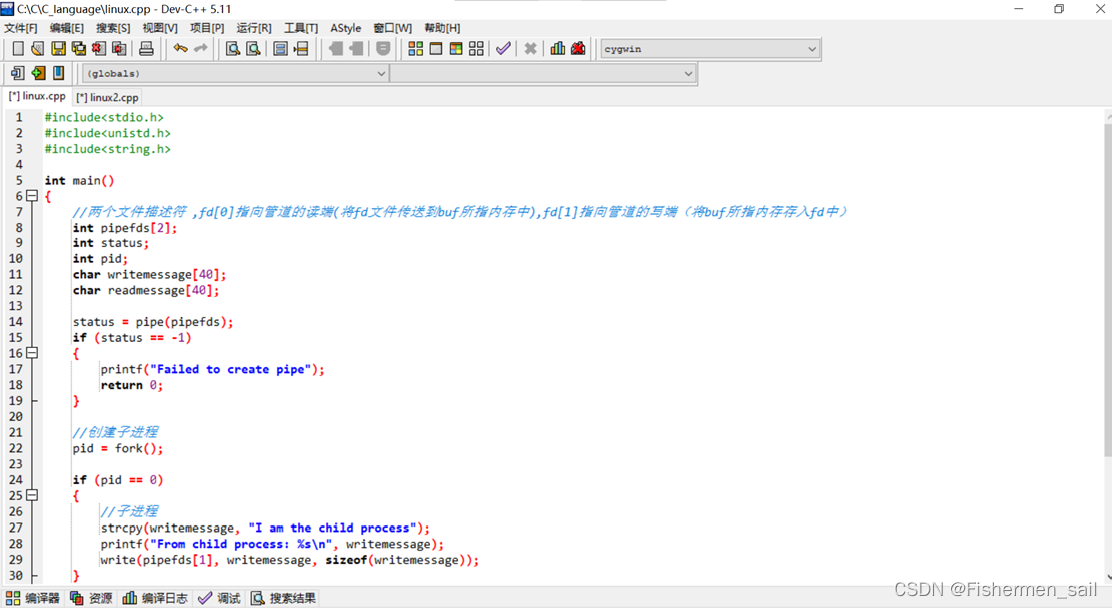

#include#include #include int main() { //两个文件描述符 ,fd[0]指向管道的读端(将fd文件传送到buf所指内存中),fd[1]指向管道的写端(将buf所指内存存入fd中) int pipefds[2]; int status; int pid; char writemessage[40]; char readmessage[40]; status = pipe(pipefds); if (status == -1) { printf("Failed to create pipe"); return 0; } //创建子进程 pid = fork(); if (pid == 0) { //子进程 strcpy(writemessage, "I am the child process"); printf("From child process: %s\n", writemessage); write(pipefds[1], writemessage, sizeof(writemessage)); } else { //父进程 read(pipefds[0], readmessage, sizeof(readmessage)); printf("From parent process: %s\n", readmessage); close(pipefds[0]); close(pipefds[1]); } return 0; } - 1
- 2
- 3
- 4
- 5
- 6
- 7
- 8
- 9
- 10
- 11
- 12
- 13
- 14
- 15
- 16
- 17
- 18
- 19
- 20
- 21
- 22
- 23
- 24
- 25
- 26
- 27
- 28
- 29
- 30
- 31
- 32
- 33
- 34
- 35
- 36
- 37
- 38
- 39
- 40
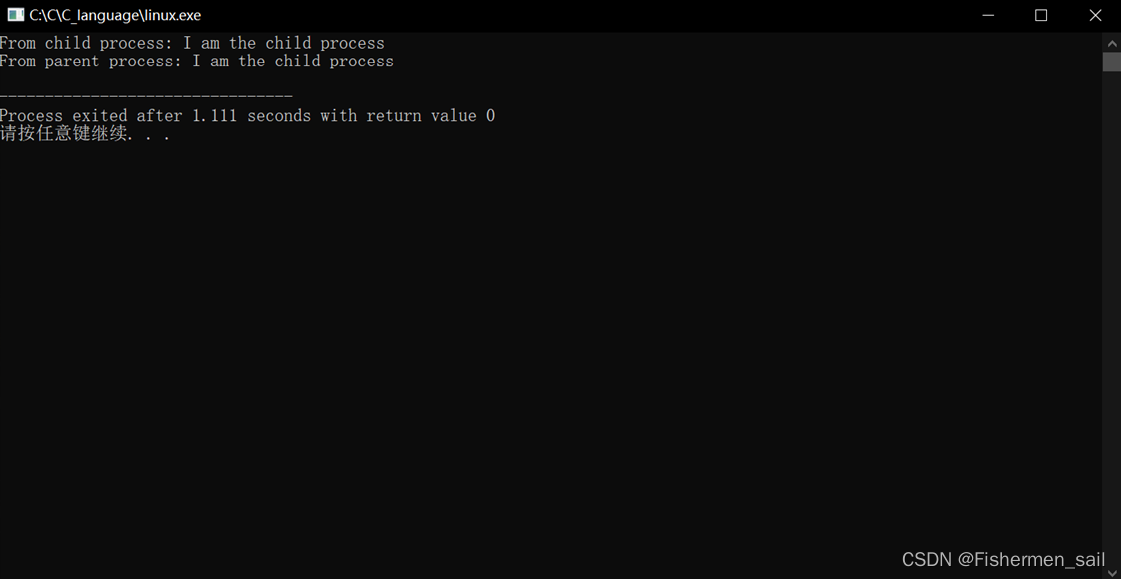
总结
使用Linux来完成程序,使得可读性比较好,便于分析,利于初步学习。对于Windows报错的原因,我目前觉得原因是“fdpipe[0] = atoi(argv[1])”这里的问题,访问了野指针。argv[1]这个参数究竟能干什么,也不是特别清除,打印出来只是一个数字,但不这样写就无法运行,如果直接用属性中高级设置给argv[1]它一个值也不行。但根据示例代码,在read之前要使用这条语句转变fdpipe[0],如果让父进程来read,父进程是没有argv[1]的,可能因为该数据不共享,如果在子进程使用这条语句也无法传给父进程,目前还找不到解决方式。
实验二
一、实验内容或题目
在父进程中创建两个子进程,并建立一个管道,两个子进程分别向管道中写入一个字符串,父进程从管道中读出字符串。
二、实验目的与要求:
利用CRT相关接口,学习在父子进程间实现一对多的管道通信。
三、实验步骤:
1、建立解决方案和项目(略)
2、参照课本3.7.5章节的例2,利用CRT LIB提供的相似性接口,实现相同的功能(使用Linux的同学调用相应的接口)
3、CRT相关api:_pipe, _spawn, _cwait, _read, _write。示例代码可以参照 :https://docs.microsoft.com/en-us/cpp/c-runtime-library/reference/pipe?view=msvc-160四、实验结果:
1)让子进程再fork出一个子进程


#include#include #include int main() { int pipefds[2]; int status; int pid1, pid2; char writemessage[40]; char readmessage[40]; status = pipe(pipefds); if (status == -1) { printf("Failed to create pipe"); return 0; } //创建子进程 pid1 = fork(); //一个fork得放里面,否则子进程执行时会在多创建一个进程 if (pid1 == 0) { //子进程2 strcpy(writemessage, "I am No.1"); printf("From child process: %s\n", writemessage); write(pipefds[1], writemessage, sizeof(writemessage)); pid2 = fork(); if (pid2 == 0) { //子进程2 strcpy(writemessage, "I am No.2"); printf("From child process: %s\n", writemessage); write(pipefds[1], writemessage, sizeof(writemessage)); return 0; } return 0; } if (pid1 != 0) { //父进程 sleep(2); read(pipefds[0], readmessage, sizeof(readmessage)); printf("From parent process: %s\n", readmessage); read(pipefds[0], readmessage, sizeof(readmessage)); printf("From parent process: %s\n", readmessage); close(pipefds[0]); close(pipefds[1]); } return 0; } - 1
- 2
- 3
- 4
- 5
- 6
- 7
- 8
- 9
- 10
- 11
- 12
- 13
- 14
- 15
- 16
- 17
- 18
- 19
- 20
- 21
- 22
- 23
- 24
- 25
- 26
- 27
- 28
- 29
- 30
- 31
- 32
- 33
- 34
- 35
- 36
- 37
- 38
- 39
- 40
- 41
- 42
- 43
- 44
- 45
- 46
- 47
- 48
- 49
- 50
- 51
- 52
- 53
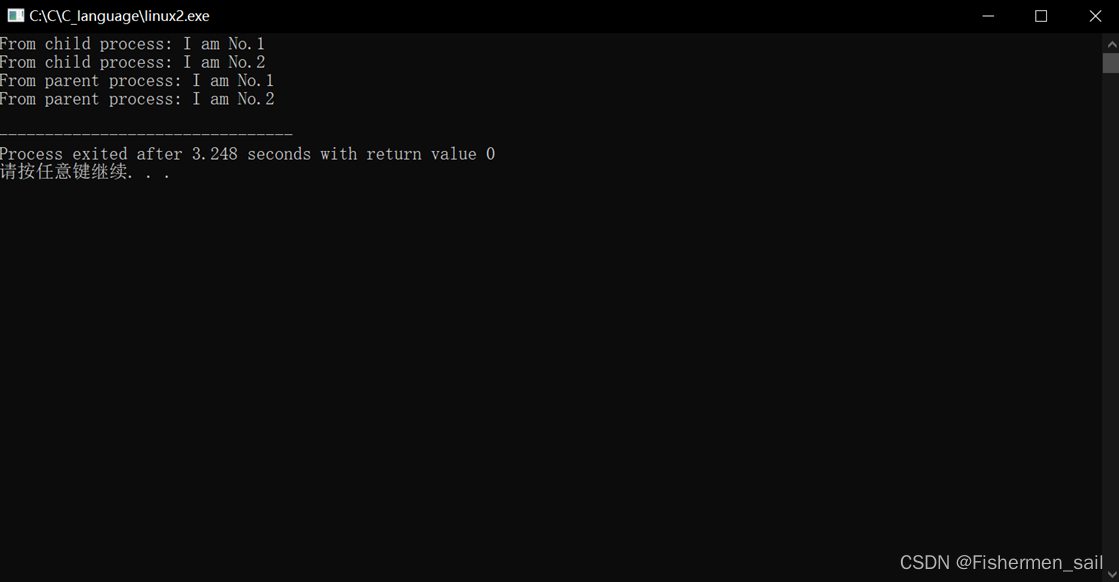
2)在父进程下fork出两个子进程


#include#include #include int main() { int pipefds[2]; int status; int pid; char writemessage[40]; char readmessage[40]; status = pipe(pipefds); if (status == -1) { printf("Failed to create pipe"); return 0; } //创建子进程 for (int i = 0; i <= 1; i++) { pid = fork(); if (pid == 0) break; } if (pid == 0) { strcpy(writemessage, "I am a child"); printf("From child process: %s\n", writemessage); write(pipefds[1], writemessage, sizeof(writemessage)); return 0; } else { sleep(2); read(pipefds[0], readmessage, sizeof(readmessage)); printf("From parent process: %s\n", readmessage); read(pipefds[0], readmessage, sizeof(readmessage)); printf("From parent process: %s\n", readmessage); close(pipefds[0]); close(pipefds[1]); } return 0; } - 1
- 2
- 3
- 4
- 5
- 6
- 7
- 8
- 9
- 10
- 11
- 12
- 13
- 14
- 15
- 16
- 17
- 18
- 19
- 20
- 21
- 22
- 23
- 24
- 25
- 26
- 27
- 28
- 29
- 30
- 31
- 32
- 33
- 34
- 35
- 36
- 37
- 38
- 39
- 40
- 41
- 42
- 43
- 44
- 45
- 46
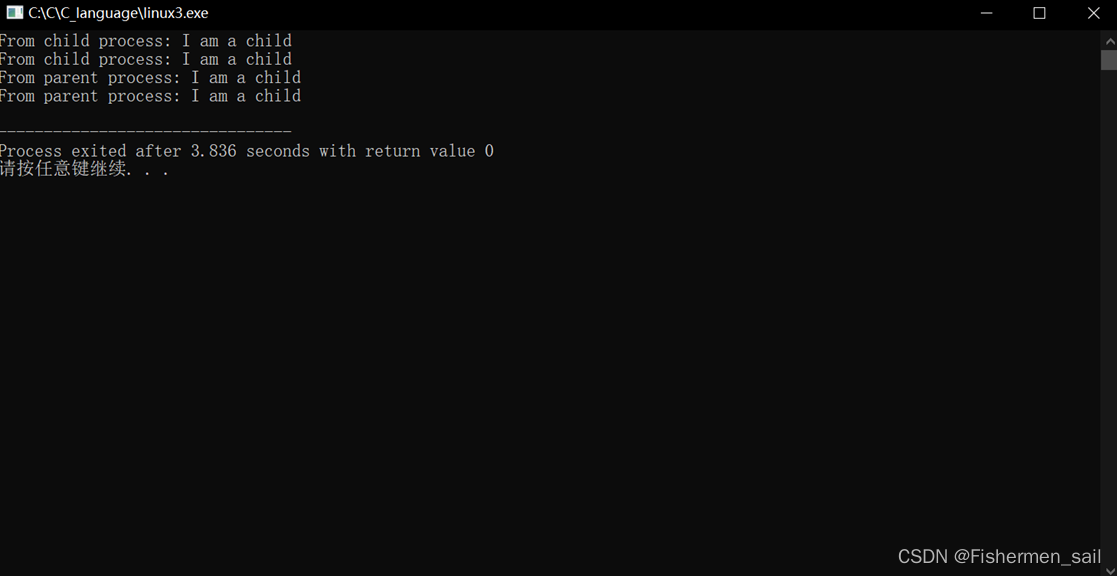
五、总结:


通过这个实验发现,fork创建进程还是比较复杂的,简单说明一下这个执行过程。在没有使用“setvbuf(stdout, NULL, _IONBF, 0)”,它的输出是第一张图这样的,起初我以为,每次fork一个子进程,子进程都会重新执行main,父进程则继续执行(根据图片输出其实也不是,如果是这个逻辑则应该输出,第一行则应该是aaaabbbbaaaabbbbFrom等,所以很困惑),但查阅资料后,知道父进程执行过的代码子进程不会执行,所以想到了Windows示例代码中使用的setvbuf,使得输出没有缓冲(具体怎么缓冲也不是特别清楚),然后输出为第二张图,至此结合第三张图也大概理解了整个流程,最关键的就是“父进程执行过的代码子进程不会执行”,为了不让子进程在循环中再在自己的进程中发动fork,只需加个判断,使得子进程退出循环。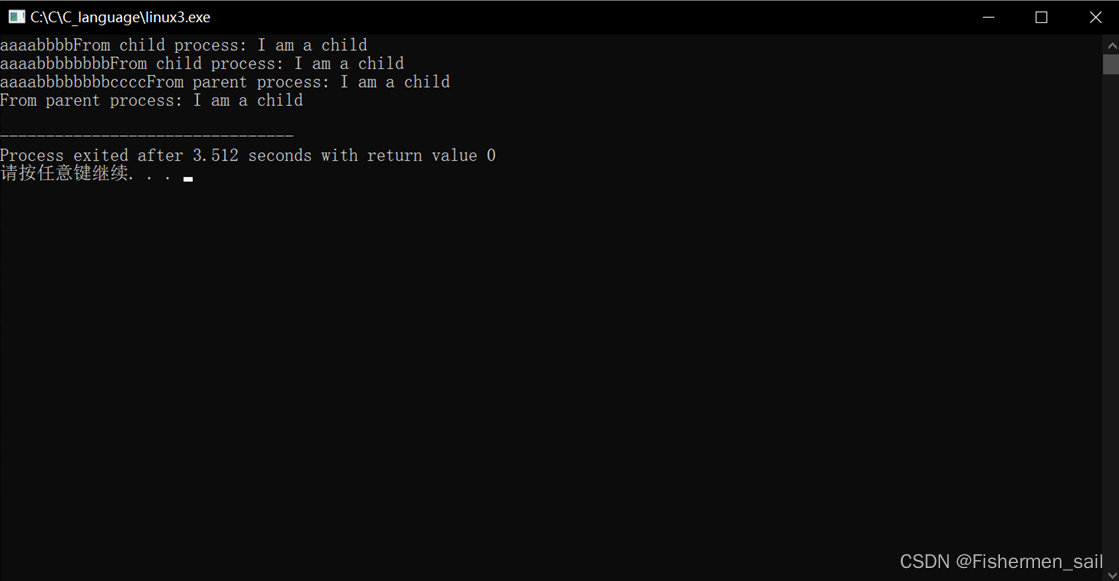
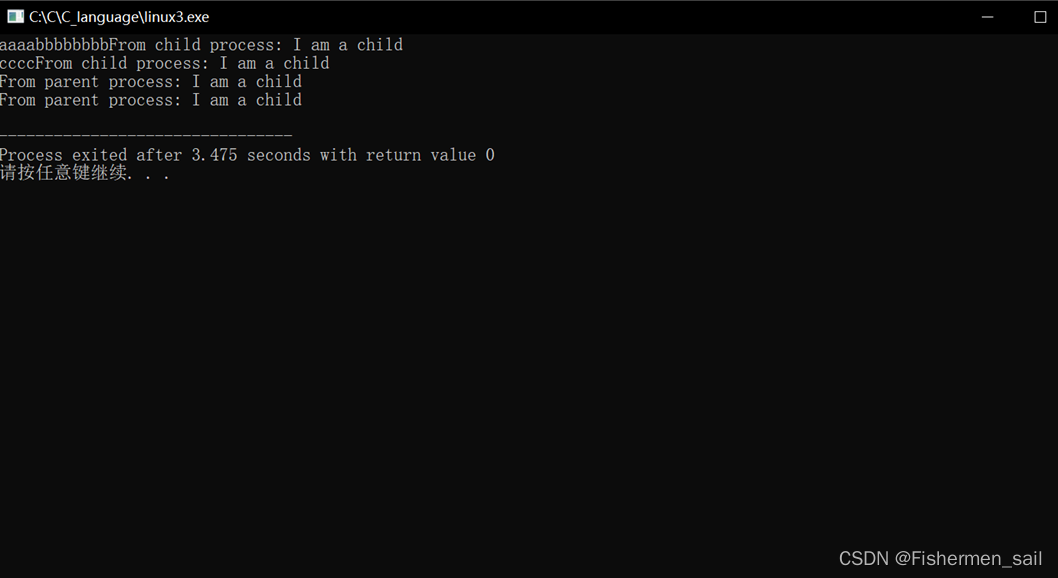

-
相关阅读:
最新AI写作创作系统源码ChatGPT源码,支持AI绘画/支持OpenAI-GPT全模型+国内AI全模型
K8S-基本介绍和集群安装
【强化学习论文合集】七.2017神经信息处理系统大会论文(NIPS2017)
康威定律对于系统架构很重要吗?
无法获取下载文件名的无奈之举
GoLand 2023.2.3(go语言开发)
Java随笔-泛型
kafka面试题(基础-进阶-高阶)
Vue watch属性
【springboot+vue项目(十四)】基于Oauth2的SSO单点登录(一)整体流程介绍
- 原文地址:https://blog.csdn.net/Fishermen_sail/article/details/127946520
